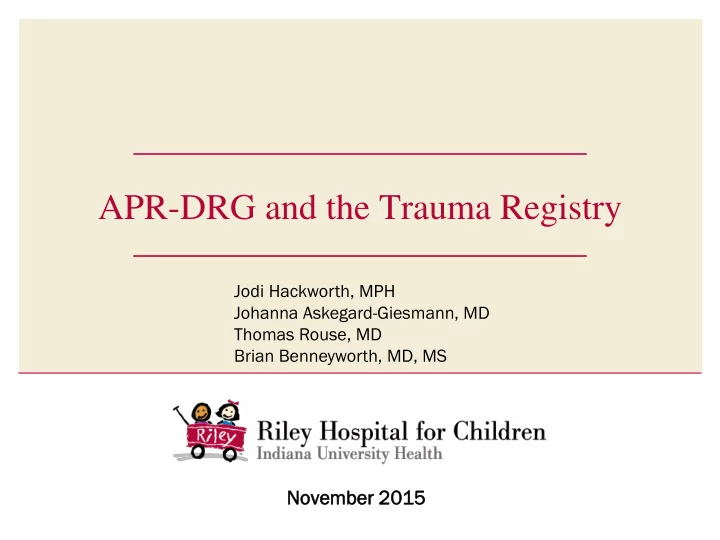

APR-DRG and the Trauma Registry Jodi Hackworth, MPH Johanna Askegard-Giesmann, MD Thomas Rouse, MD Brian Benneyworth, MD, MS Nove vemb mber er 2015 15
Conflict of Interests Disclosures • Jodi Hackworth and her co-authors have documented that they have no relevant financial relationships to disclose or conflict of interests to resolve
Background • Hospitals and hospital based programs need data that is: – Readily available – Measures outcomes and evaluates programs – Can help plan for resource utilization • Hospital administration uses administrative data for human and capital investment allocation • Significant differences between administrative databases and clinical registry data exist.
Background- Data Set Differences Adminis inistr trat ative Data Trauma auma Registr istry y Data Readily available Must be abstracted within 60 days of discharge per ACS Standardized across Only NTDB data point standardized hospitals nationally Low cost for data entry High cost for data entry/abstraction Collected on all patients Detailed clinical data ICD-9/10 CMS coding Trauma Registry Coding Guidelines rules and sources
Objective To compare the identification of trauma patients using All Patient Refined Diagnosis Related Groups (APR-DRG) to the Trauma Registry and estimate differences on utilization and diagnosis.
Methods • Retrospective Descriptive Analysis Study • Data abstraction – Admitted trauma registry patients from January 2012-December 2013 (N= 1942) – Encounters from Administrative database identified by trauma-related APR-DRGs (N= 1004) – Other encounters for trauma registry patients from administrative database that did not have a trauma-related APR-DRG • Patients and encounters were linked manually via MRN/FIN
Methods • Compared the following variables to see the level of agreement between the two datasets: – Overall Agreement – Severity of Illness – Utilization • ICU and Surgical – Diagnostic categories • Head Trauma, Simple Fractures, Abdominal Trauma • IRB Approved
Methods • Definitions for comparisons purposes Variable ables APR-DR DRG G Defini nitio tion Registr istry Defini niti tion Injury Category APR-DRG SOI (Severity of Illness) ISS (Injury Severity Score) Hospital LOS Hospital Full Days Hospital Full Days ICU Stay Billing Flag- Days where ICU stay Full Days- Manually occurred Calculated Mortality Discharge Disposition Discharge Status in Registry- Alive or Dead Surgery Primary Procedure OR Procedure(s) Head Injury APR-DRG Category 20, 55, 56, AAAM AIS coding definition 57, 910 of Head Injury Craniotomy APR-DRG Category 20 or 910 Surgical Procedure List Simple Extremity APR-DRG 308 Across all Diagnosis Codes Fractures Abdominal Trauma APR-DRG 911 Across all Diagnosis Codes
Results- Overall Agreement Administrative Trauma Registry Data with Trauma APR-DRGs 169 trauma 1107 Trauma 835 Trauma APR-DRG Registry Registry records not Records Did Not ot Records had included in have a trauma a trauma registry APR-DRG APR-DRG
Results- Overall Severity Injur ury y Categor egory Matched hed Trauma auma Total al Traum auma Regist egistry APR-DR DRG G N=1942 942 N=835 Minor 57.6% (481/835) 78.8% (1530/1942) Moderate 24.6% (205/835) 12.3% (239/1942) Serious 13.1% (109/835) 5.4% (104/1942) Critical 4.8% (40/835) 3.6% (69/1942)
Results- ICU Utilization Injur ury y Categor egory Matched hed Trauma auma Total al Traum uma APR-DR DRG G N=203 Registr gistry N=295 Minor 22.2% (45/203) 32.2% (95/295) Moderate 24.1% (49/203) 25.1% (74/295) Serious 34.0% (69/203) 20.7% (61/295) Critical 19.7% (40/203) 22.0% (65/295) Median Hospital LOS 3 days 5 days Intubated Proportion 36.5% (74/203) 44.4% (131/295) Mortality 6.9% (14/203) 6.1% (18/295)
Results- Surgical Utilization Injur ury y Categor egory Matched hed Trauma auma Total al Traum uma Regis gistr try APR-DR DRG G N=177 N=864 Minor 23.7% (42/177) 80.0% (691/864) Moderate 32.8% (58/177) 10.9% (94/864) Serious 31.6% (56/177) 3.6% (31/864) Critical 11.9% (21/177) 5.6% (48/864)
Results- Head Injury APR/DR R/DRG Matched hed Trauma auma Total al Traum uma Reg egistr istry Severity/ erity/IS ISS S APR-DR DRG N=705 N=515 Minor 71.1% (366/515) 69.3% (489/705) Moderate 16.9% (87/515) 15.2% (107/705) Serious 8.5% (44/515) 7.8% (55/705) Critical 3.5% (18/515) 7.7% (54/705) Craniotomies 6.8% (35/515) 7.5% (53/705) Median Hospital LOS 1 day 1 day Proportion of 23.9% (123/515) 22.6% (169/705) Patients in ICU Mortality 2.1% (11/515) 2.5% (18/705)
Results- Simple Fractures Descripti cription on Matched hed Trauma auma Tot otal al Trauma ma Regis istr try N=672 672 APR-DR DRG G N=97 Number of Lower 95 268 Extremity Fractures (based off of diagnosis and includes one acetabulum fracture) Number of Upper 2 391 Extremity Fractures (based off of diagnosis) Number of Both Upper n/a 13 and Lower Extremity Fractures Number of Operative 96 570 Procedures
Results- Abdominal Trauma Injur ury Matched hed Total al Traum uma Trauma auma APR- Registr gistry DRG N=3 N=153 Abdominal Trauma 3* 153 Spleen Injuries- Using Diagnosis 14 65 Liver Injuries- Using Diagnosis 9 53 Pancreas Injuries- Using Diagnosis 0 12 Kidney Injuries- Using Diagnosis 4 23 Number of Spleen Surgical Procedures 1 1 Number of Liver Surgical Procedures 0 1 Number of Pancreas Surgical 0 4 Procedures Number of Kidney Surgical Procedures 2 2
Limitations • Descriptive study – No true statistical comparisons • APR-DRG severity includes comorbidities and complications versus ISS score which is only anatomic based. • Classification of severely injured patients with trachs or primary diagnosis of physical child abuse not classified under trauma related APR-DRG
Conclusions • Trauma APR-DRGs only capture a fraction of the trauma population included in the registry – Best with head injury • Trauma APR-DRGs tend to be the more severely ill patients – Difficult for administrators to accurately look at utilization for human resource and capital needs • APR-DRG administrative data should not be used as the only data source for evaluating the needs of a trauma program
Thank You. Questions????
Recommend
More recommend